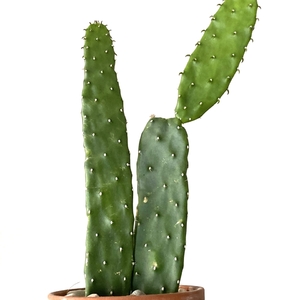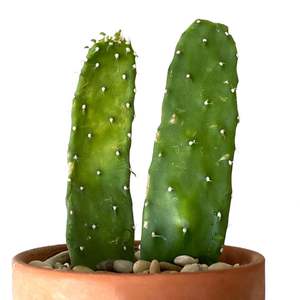植物经验
详细说明
Prickly pears are a subgroup of Opuntia, identified by their wide, flat, branching pads, and are often called nopal cactus or paddle cactus. Most varieties have a combination of detachable spines and tufts of barbed bristles (glochids) that can cause significant allergic skin reactions. There are also spineless varieties like O. ellisiana and others.
The pads, flowers and fruit of most varieties are edible after careful cleaning. Most prickly pear plants are found in warm, dry climates like the Southwest, although there are some cold-hardy varieties such as the Eastern prickly pear (O. humifusa). As the plants prepare for winter, pads may begin to look shriveled and wilted, but they will green up quickly in spring.
Pruning:
It’s not necessary to prune prickly pears, but they can be cut back. Remove individual pads as needed to maintain shape and size. Use tongs to hold the pad and a sharp knife to cut it off at the joint, or line where it connects to the next pad. Pads can be calloused off to be planted elsewhere or shared with friends. See more on propagating below.
Soil:
Prickly pears prefer alkaline to neutral soil. More importantly, however, the soil needs to drain well, as residual moisture or puddling can cause the plant to rot.
Amendments & Fertilizer:
Fertilize young plants with a balanced 10-10-10 fertilizer. For established plants, a 5-10-10 or even 0-10-10 water-soluble fertilizer will promote more flowers and fruit. If you are growing for the pads, use a fertilizer that is high in nitrogen.
Watering:
Prickly pears are extremely drought tolerant. Don’t water newly propagated pads for the first month. After that, water every two to four weeks for the first year — twice a month in summer and once a month other times of the year. In most areas, rainfall will be enough to sustain established plants. Supplement in times of drought with the twice-a-month/once-a-month seasonal schedule.
Propagation:
Initial growth from seed is slow and it may take 3 to 4 years before your plant produces flowers and fruit. The seeds need shade to germinate and should be kept moist until that time.
Propagation from pads is much simpler and yields faster results. Here's how:
Pads that are at least 6 months old can be cut off by following the pruning instructions above.
Set the pads out in a dry area with light shade and allow the cut end to form a callus. This prevents the new plant from rotting at the base and can take 2 to 4 weeks in warm, dry weather, longer if it is cool or humid.
Once fully calloused over, plant pads in a mixture of half soil and half sand at a depth of 1 inch. If planted any deeper, your plant can rot.
Don’t water it for the first month, as there is enough moisture within the pad to sustain itself.
Prop it up with rocks or other means of support until roots grow over the next month or so. After a month, there should be enough roots that your plant can stand on its own, but continue the support if it’s still a little wobbly.
You can water it at this time as well and follow the watering guidelines above, making sure to let it dry out completely in between.
On new plants, flowers and fruit will usually appear by the second or third pad that grows.
Diseases and Pests:
Prickly pears don’t normally suffer from any serious disease or insect problems, although they can be affected by rot if grown with poor drainage.
The pads, flowers and fruit of most varieties are edible after careful cleaning. Most prickly pear plants are found in warm, dry climates like the Southwest, although there are some cold-hardy varieties such as the Eastern prickly pear (O. humifusa). As the plants prepare for winter, pads may begin to look shriveled and wilted, but they will green up quickly in spring.
Pruning:
It’s not necessary to prune prickly pears, but they can be cut back. Remove individual pads as needed to maintain shape and size. Use tongs to hold the pad and a sharp knife to cut it off at the joint, or line where it connects to the next pad. Pads can be calloused off to be planted elsewhere or shared with friends. See more on propagating below.
Soil:
Prickly pears prefer alkaline to neutral soil. More importantly, however, the soil needs to drain well, as residual moisture or puddling can cause the plant to rot.
Amendments & Fertilizer:
Fertilize young plants with a balanced 10-10-10 fertilizer. For established plants, a 5-10-10 or even 0-10-10 water-soluble fertilizer will promote more flowers and fruit. If you are growing for the pads, use a fertilizer that is high in nitrogen.
Watering:
Prickly pears are extremely drought tolerant. Don’t water newly propagated pads for the first month. After that, water every two to four weeks for the first year — twice a month in summer and once a month other times of the year. In most areas, rainfall will be enough to sustain established plants. Supplement in times of drought with the twice-a-month/once-a-month seasonal schedule.
Propagation:
Initial growth from seed is slow and it may take 3 to 4 years before your plant produces flowers and fruit. The seeds need shade to germinate and should be kept moist until that time.
Propagation from pads is much simpler and yields faster results. Here's how:
Pads that are at least 6 months old can be cut off by following the pruning instructions above.
Set the pads out in a dry area with light shade and allow the cut end to form a callus. This prevents the new plant from rotting at the base and can take 2 to 4 weeks in warm, dry weather, longer if it is cool or humid.
Once fully calloused over, plant pads in a mixture of half soil and half sand at a depth of 1 inch. If planted any deeper, your plant can rot.
Don’t water it for the first month, as there is enough moisture within the pad to sustain itself.
Prop it up with rocks or other means of support until roots grow over the next month or so. After a month, there should be enough roots that your plant can stand on its own, but continue the support if it’s still a little wobbly.
You can water it at this time as well and follow the watering guidelines above, making sure to let it dry out completely in between.
On new plants, flowers and fruit will usually appear by the second or third pad that grows.
Diseases and Pests:
Prickly pears don’t normally suffer from any serious disease or insect problems, although they can be affected by rot if grown with poor drainage.
花相册 (2)


kensong
2020年04月26日

Growing fast. New head.


kensong
2020年02月22日

Gift from Mona.







